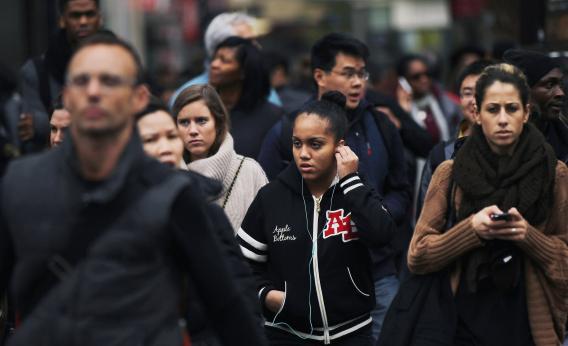There are lots of things worth worrying about. Human extinction is not one of them.
Sure, an asteroid could wipe us out a la Stegosaurus. We could do ourselves in via some newfangled (or newly freed) virus. But humans going the way of the dodo through failure to breed? It ain’t gonna happen.
But that seems to be what keeps writer Jeff Wise up at night. In a Jan. 9 piece in Slate titled “About That Overpopulation Problem,” Wise includes this terror-inducing line: “And in the long term—on the order of centuries—we could be looking at the literal extinction of humanity.”
Wise writes that human population hit 7 billion people in 2012. “It took humankind 13 years to add its 7 billionth. That’s longer than the 12 years it took to add the 6 billionth—the first time in human history that interval had grown,” he wrote.
Except he’s wrong. We hit 6 billion in 1999 and 7 billion in 2011—the same number of years it took to grow from 5 billion to 6 billion, even in the midst of a global recession of the type that tends to reduce births. And this rate of growth is the human reproduction equivalent of a supersonic jet. In fact, it took 130 years to increase our human population from 1 billion to 2 billion.
Not satisfied with simple math errors, Wise moves on to cherry-picking data.
“Even in sub-Saharan Africa, where the average birthrate remains a relatively blistering 4.66, fertility is projected to fall below replacement level by the 2070s,” he writes.
Or not. The number Wise cites comes from the United Nations, which has three projections for future fertility. The one Wise cites is the low variant, which most demographers laugh at. In the more commonly cited medium variant, sub-Saharan Africa’s fertility rate in 2070 would remain at 2.43 births per woman—comfortably above replacement rate. And many demographers think even that rate is unrealistically low.
But what about the rest of the world? Isn’t America’s population shrinking? Nope.
The population of the United States is expected to grow from about 315 million today to a boisterous and bustling 420 million in 2060. Our growth rate has slowed, but we’re still growing like a weed because each year the population base is larger. In fact, we’ll probably grow faster once the economy improves since recessions tend to delay childbearing. The average American woman still wants two kids—just like her mom did in the 1970s.
It is true that many nations—including the United States—will need to adjust to an older population. But it’s not any reason wax nostalgic about bygone days when women had no choice but to have large families, which Wise seems to do.
“One of the first things that countries do when they start to develop is educate their young people, including girls,” he wrote. “That dramatically improves the size and quality of the workforce. But it also introduces an opportunity cost for having babies.”
Why, yes, it does! And I bet most women today are thrilled that they have the choice to make family, a job or both their priority. If we have to adjust to a smaller population to allow the half of the population that’s historically been denied choice to gain some measure of control over their own lives, I’d say that’s a fine trade-off.
If Jeff Wise wants to worry about the world running out of babies, he’s certainly welcome to. As for me, if I feel compelled to worry about unlikely catastrophes, I’ll go with things that seem more likely. Like massive asteroids. Or dodo flu.
John Seager is president of Population Connection, the nation’s largest grassroots population organization, which is formerly known as Zero Population Growth. The organization’s website is populationconnection.org.
Jeff Wise responds:
I guess I need to clarify that I’m not actually worried about the extinction of the human race and certainly had no intention of stirring up public angst; I just find it extremely interesting that that’s where current trends are taking us.
As to my assertion that it’s taken us longer to add the last billion, we’re actually both right; you can do the math either way. The UN projected the population to top 7 billion in 2011, the US Census Bureau called it for 2012. Both say it topped 6 billion in 1999. (See here and here.)
The underlying thesis, however, is undisputed: that population increase is slowing. (Here’s a nice graphical depiction.)
Where I think Seager’s critique goes badly off the rails—offensively so, really—is when he utterly misrepresents my position on reproductive freedom. He imagines that I “wax nostalgic about bygone days when women had no choice but to have large families.” I do not see how he could draw this inference; it is the opposite of my opinion. He does hit the mark when he writes: “If we have to adjust to a smaller population to allow the half of the population that’s historically been denied choice to gain some measure of control over their own lives, I’d say that’s a fine trade-off.” I agree wholeheartedly.
Finally, Seager says I cherry-pick data regarding Africa’s fertility rate, but that’s not the case; the data I cite is the IIASA’s median projection, not the United Nations’ low projection.
